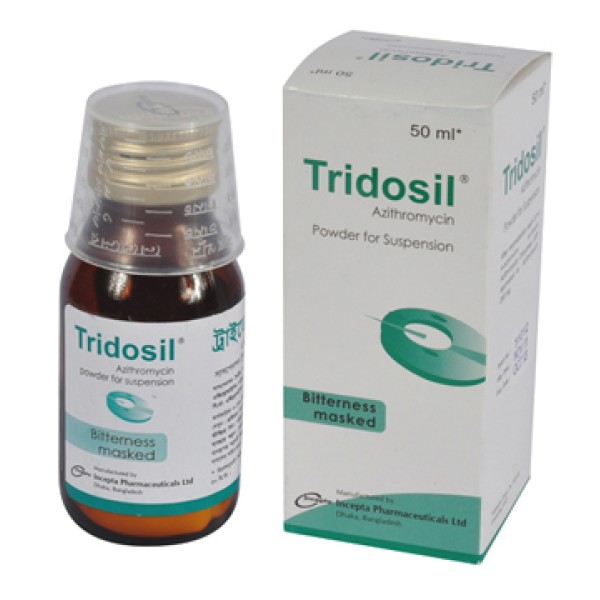
- Stock: In Stock
- Brand: Incepta Pharmaceuticals
- Product ID: Azithromycin
100% Secure Payment

Tridosil 50 ml Susp
Description
Azithromycin is an azalide antibiotic, a subclass of macrolide antibiotic. It acts by binding to the 50s ribosomal subunit of susceptible microorganisms and thus interfering with microbial protein synthesis. Azithromycin has been shown to be active against most strains in the following microorganisms, both In vitro and in clinical infections:
Gram-positive microorganisms: Staphylococcus aureus, Streptococcus agalactiae, Streptococcus pneumoniae, Streptococcus pyogenes.
Gram-negative microorganisms: Haemophilus ducreyi, Haemophilus influenzae, Moraxella catarrhalis, Neisseria gonorrhoeae, Escherichia coli.
Other microorganisms: Chlamydia pneumoniae, Chlamydia trachomatis, Mycoplasma pneumoniae, Bacteroides fragilis, Legionella pneumophila, oxoplasma gondii.
Indications
Azithromycin is indicated for infections caused by susceptible organisms in-
Upper respiratory tract infections including sinusitis, pharyngitis and tonsillitis
Lower respiratory tract infections including bronchitis, acute bacterial exacerbations of chronic obstructive pulmonary
disease (COPD)
Otitis media
Skin and soft tissue infections including cellulitis, pyoderma, erysipelas, wound infections
Diarrhea, Shigellosis
Sexually transmitted diseases, especially in the treatment of non-gonococcal urethritis and cervicitis due to Chlamydia trachomatis
Genital ulcer disease in men due to Haemophilus ducreyi (chancroid)
Mild or moderate typhoid due to multiple-antibacterial resistant organisms
Prophylaxis against a-hemolytic (viridans group) streptococcal bacterial endocarditis
Other infections including odontogenic infections, bartonella infections, toxoplasmosis, babesiosis
Dosage & Administration
Azithromycin tablet can be taken with or without food. Azithromycin suspension should be taken at least 1 hour before or 2 hours after meal.
Oral:
Adult:
For respiratory tract infections, otitis media and skin & soft tissue infections: 500 mg once daily for 3 days or an alternative to this as 500 mg once on day 1, followed by 250 mg once daily for next 4 days. For sexually transmitted diseases like genital ulcer, non-gonococcal urethritis and cervicitis due to Chlamydia trachomatis : a single 1 gm (1000 mg) dose. For the treatment of urethritis and cervicitis due to Neisseria gonorrhoeae : a single 2 gm (2000 mg) dose. In typhoid, 500 mg once daily for 7 days. In Cholera, a single 1 gm (1000 mg) dose. In Shigellosis, 500 mg once on day 1, followed by 250 mg once daily for next 4 days.
Children:
Side Effects
Azithromycin is well tolerated with a low incidence of side efects. The side effects include nausea, vomiting, abdominal discomfort (pain/cramps), flatulence, diarrhea, headache, dizziness, and skin rashes and are reversible upon discontinuation of therapy. Reversible elevations in liver transaminases have been observed occasionally. Transient mild reductions in neutrophil counts have occasionally been observed in clinical trials, although causal relationship to Azithromycin has not been established.
Precautions
As with any antibiotic, observation for signs of super infection with non-susceptable organisms, including fungi, is recommended. Precaution should be taken in patients with more severe renal impairment.
Use in Pregnancy & Lactation
Pregnancy: US FDA pregnancy category B. In the animal studies, no evidence of harm to the fetus due to Azithromycin was found. Because animal reproduction studies are not always predictive of human response, Azithromycin should be used during pregnancy only if clearly needed.
Lactation: It is not known whether Azithromycin is excreted in human milk. Because many drugs are excreted in human milk, caution should be exercised when Azithromycin is administered to nursing mother.
Drug Interaction
Peak serum levels but not the total extent of absorption were reduced by the presence of magnesium and aluminum-containing antacids. Azithromycin should be taken at least 1 hr before or 2 hrs after these antacids. In patients receiving ergot alkaloids, Azithromycin should be avoided concurrently because of the possibilty of ergotism result in from interaction of Azithromycin with the cytochrome P-450 system However, no cases of such interaction have been reported. Macrolides have been known to increase the plasma concentration of digoxin and cyclosporine. Therefore, if co-administration is necessary caution should be exercised and serum levels of digoxin and cyclosporine should be checked. There have been no pharmacokinetic drug interactions between Azithromycin and warfarin, theophylline, carbamazepine, methylprednisolone and cimetidine.
Over Dose
There are no data available on overdose with Azithromycin. Typical symptoms of overdosage with macrolide antibiotics include hearing loss, severe nausea, vomiting and diarrhoea. Gastric lavage and general supportive measures are indicated.



























